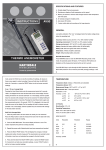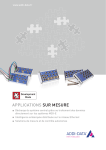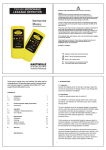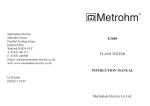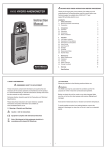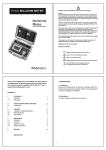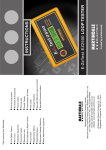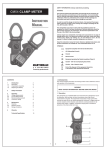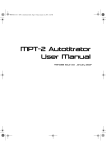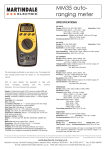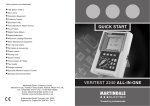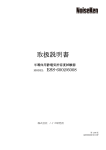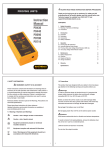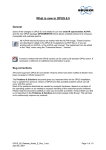Download Manual - Martindale Electric
Transcript
Metrohm Martindale Electric Metrohm House Penfold Trading Estate Imperial Way Watford WD24 4YY T: 01923 441717 F: 01923 446900 Email: [email protected] web: www.martindale-electric.co.uk E3511 HIGH VOLTAGE INSULATION TESTER INSTRUCTION MANUAL LITE3511 ISSUE 9 01/07 ® Martindale Electric The purchaser agrees to assume all liability for any damages and bodily injury which may result from the use or misuse of the product by the purchaser, his employees, or others, and the remedies provided for in this warranty are expressly in lieu of any other liability Martindale Electric Company Ltd may have, including incidental or consequential damages. Martindale Electric Company Ltd reserve the right to discontinue models at any time, or change specifications, price or design, without notice and without incurring any obligation. TABLE OF CONTENTS PAGE 1. SAFETY RULES 2-3 2. DESCRIPTION 2.1 GENERAL 3-4 2.2 FRONT PANEL LAYOUT 5 2.3 TYPICAL TERMINAL VOLTAGE CHARACTERISTICS 5 3. PREPARATION FOR USE 6 4. INSTRUCTIONS FOR USE 4.1 PRELIMINARY CHECKS 7 4.2 TESTING INSULATION TO EARTH 7-8 4.3 TESTING INSULATION BETWEEN CONDUCTORS 8 4.4 GUARD TERMINAL 8 4.5 AC INTERFERENCE 9 4.6 INTERNAL POWER SUPPLY 9 4.7 ‘BAT’ INDICATION 9-10 4.8 INPUT LIMITS 10 5. APPLICATIONS 10-11 6. TECHNICAL SPECIFICATION 6.1 ELECTRICAL 11-13 6.2 MECHANICAL 13 6.3 ENVIRONMENTAL 13 7. SPARES AND ACCESSORIES 14 8. LIMITED WARRANTY 15 ! 1. SAFETY RULES The E3511 has been designed with safety in mind. However, no design can completely protect against incorrect use. Electrical circuits can be dangerous and even lethal through lack of caution or poor safety practices. The following rules will minimise the danger:1.1 Read the Instruction Manual carefully and completely before using this instrument. Fully understand the instructions before using this tester. Follow the instructions in the Manual for every test. Take all the precautions recommended. Never exceed the limits of this tester. 1.2 The circuit to be tested must be de-energised and isolated before connections are made for an insulation test. 1.3 Do not touch the circuit being tested during an insulation test. 1.4 After an insulation test, capacitive circuits must be discharged before disconnecting the test leads. 1.5 Do not use test leads, probes or crocodile clips that are dirty, damaged or have broken or cracked insulation. Such accessories should be immediately removed and repaired. 1.6 Always disconnect the supply lead to de-energise the tester before replacing the internal fuse, and don’t press the TEST button. Always replace the fuse with the type specified and ensure that it is correctly fitted. 1.7 Never latch the TEST button on unless it is absolutely necessary. Be extremely careful not to cause a hazard if this is done. 1.8 Always connect the HV leads to the high (H) and low (L) sockets before switching the tester on. 1.9 Do not touch any part of the test leads or croc clips when carrying out insulation tests at voltages greater than 1000V. Always keep your hands behind the hand guards on the probes and crocodile clips. 1.10 This instrument must not be used in wet conditions. 8. LIMITED WARRANTY Martindale Electric Company Ltd warrant instruments and test equipment manufactured by them to be free from defective material or factory workmanship and agree to repair or replace such products which, under normal use and service, disclose the defect to be the fault of our manufacturing, with no charge for parts and service. If we are unable to repair or replace the product, we will make a refund of the purchase price. Consult the Instruction Manual for instructions regarding the proper use and servicing of instruments and test equipment. Our obligation under this warranty is limited to repairing, replacing or making refund on any instrument or test equipment which proves to be defective within 24 months from the date of original purchase. Proof of purchase date required. This warranty does not apply to any of our products which have been repaired or altered by unauthorised persons in any way so as, in our sole judgement, to injure their stability or reliability, or which have been subject to misuse, abuse, misapplication, negligence or accident, or which have had the serial numbers altered, defaced or removed. Accessories, not of our manufacture, used with this product are not covered by this warranty. To register a claim under the provisions of this warranty, return the instrument or test equipment to Martindale Electric Company Ltd, Metrohm House, Penfold Trading Estate, Imperial Way, Watford WD24 4YY. Upon our inspection of the product we will advise you as to the disposition of your claim. ALL WARRANTIES IMPLIED BY LAW ARE HEREBY LIMITED TO A PERIOD OF TWENTY FOUR MONTHS, AND THE PROVISIONS OF THE WARRANTY ARE EXPRESSLY IN LIEU OF ANY OTHER WARRANTIES EXPRESSED OR IMPLIED. NOTE: This instrument should only be used by a competent, suitably trained person. -2- -15- Explanation of Symbols Used 7. SPARES AND ACCESSORIES Test Lead Kit (2m) METDFK 0075A Test Lead Kit (10m) METDFK 0075C Caution, risk of electric shock ! Caution, refer to Instruction Manual Terminal of measuring circuit connected to accessible conductive parts (see IEC 1010, Part 5.1.6(c)). 2.DESCRIPTION 2.1 GENERAL The E3511 is a portable, high voltage, insulation tester that can be operated from its internal, rechargeable batteries or from the external AC supply. Four test voltages, 0.5kV, 1.0kV, 2.5kV and 5.0kV are available with the same measurement resistance range of 100kΩ to100GΩ. The tester can also function as a volt metre with a range of 1000V AC or DC. This instrument has two principle circuits; a high voltage DC converter and a log ratio amplifier. The high voltage DC convertor generates the test voltage selected at the measurement terminals.The log ratio amplifier compares the current flowing through the measurement terminals with the voltage across them. The output of this amplifier is, therefore, the logarithm of the insulation resistance across the measurement terminals and this is displayed on the meter. When the TEST push button is not pressed, the tester operates as a volt meter. This gives an indication that the equipment being tested is deenergised before an insulation test and monitors the discharge of capacitive circuits when the TEST push button is released. The resistance associated with the volt meter acts as a discharge circuit so that, when the TEST push button is released after an insulation test, any capacitive circuit is automatically discharged. -14- -3- An integral battery charger unit recharges the internal batteries when AC power is supplied to the tester. The indicator, adjacent to the mains socket, lights when the batteries are being recharged. The BAT indicator lights if the batteries are in a charged state when the TEST push button is pressed. The E3511 can continue to be operated whilst the batteries are being recharged. Fuses: The tester is packaged in a rugged, moulded plastic case with an integral carrying handle. The hinged, detachable lid protects the front panel and provides storage for the Instruction Manual and accessories. 6.2 MECHANICAL The controls, displays and terminals are mounted on the front panel. A four position rotary switch selects the test voltage required. The ‘TEST’ pushbutton is pressed to perform an insulation test and it can be latched into its ‘ON’ position by pressing down and turning clockwise. The high (H) and low (L) measurement terminals are latching coaxial sockets that enable the test leads to be screened to reduce errors due to leakage. The guard (G) terminal is a shrouded, safety socket and it enables errors due to surface leakage to be eliminated. The mains input socket has an integral fuse holder and the indicator adjacent to it lights when an AC supply is supplied to the tester. The indicator marked BAT lights when the TEST push-button pressed if the internal battery is in a charged state. The moving coil meter has a white scale plate with a black upper scale for insulation resistance measurements and a red lower scale for voltage measurements. The standard accessory kit consists of the HV, screened test leads with probes, a guard lead, a mains supply lead for battery charging, three crocodile clips and an Instruction Manual. The supplied test leads and croc clips are rated at CAT III 1000V. They should NOT BE HAND HELD OR TOUCHED when using insulation test voltages greater than 1000V. The physical sizes required to provide full levels of safety isolation at higher voltages would render the test leads unusable in many applications therefore safe working practices must be observed. -4- 0.2A, F, HBC, ceramic, DIN fuse on power inlet; 0.63A, T, HBC, ceramic, DIN fuse on battery Case Length: 330mm Case Width: 263mm Case Height: 144mm Scale Length: 133mm Case Material: Yellow ABS, black and clear polycarbonate Weight: 4.2kg (with batteries) Bump: To IEC68-2-29 Vibration: To IEC68-2-6 Drop: To IEC1010, Clause 8.4 Impact: To IEC1010, Clause 8.2 6.3 ENVIRONMENTAL Operating Temperature Range: Storage Temperature Range: 15ºC to +55ºC -25ºC to +65ºC Cold Temperature: To IEC68-2-1 Dry Heat: To IEC68-2-2 Damp Heat: To IEC68-2-3 -13- Short Circuit Current: 1.2mA nominal Ripple Voltage: <10V peak to peak (R<10MΩ) Hum Rejection: 2mA RMS on 5kV range Capacitor Charging Time: 15 seconds nominal to charge a 2μF capacitor to 5kV Capacitor Discharge Time: 2 seconds nominal to discharge a 2μF capacitor from 5kV to 50V Voltmeter Range: 1000 volts AC or DC Voltmeter Range Accuracy: ±1.5% of scale length Maximum Voltage on Measurement Terminals: 2.2 FRONT PANEL LAYOUT 2.3 TYPICAL TERMINAL VOLTAGE CHARACTERISTICS 1kV across H and L terminals; 1kV across H and guard; 250V across L and guard Internal Battery: 12V, 1.25AH, NiCad Pack Battery Low Voltage: 10.5 volts nominal Maximum Battery Consumption: 400mA Battery Life: 2 - 8 hours typical Internal Power Supply/Charger: 240VAC, ±10%, 50/60Hz, 18VA or 120VAC, ±10% Protection: Safety: Over-voltage and over-current protection on measurement terminals; VDR on power inlet socket; GDT on L terminal EMC: Meets EN 50081-1 EN 50082-1 LVD: Meets BS EN 61010 -12- Fig. 2 -5- (b) PREPARATION FOR USE This parameter is obtained by monitoring the insulation under test for 60 seconds. The dielectric absorption ratio is then the ratio of the insulation resistance reading at 60 seconds to that at 30 seconds. This technique provides conclusive results on the quality of the insulation, which are independent of temperature and equipment size. A ratio less than 1.25 is cause for investigation and possible repair of the equipment tested. Current flowing in the surface leakage path is diverted through the guard terminal and is not included in the measurement. In this way, the insulation measured is only the radial insulation value. The Metrohm E3511 is delivered in a shipping container. When it is unpacked, it should be checked for any visible signs of damage, and the preliminary checks described in the operation instructions should be performed to ensure that it is operating correctly. If there is any sign of damage or if the instrument does not operate correctly, return it to the supplier. This instrument can be powered from a power source of 240VAC, 50/60Hz or 120VAC, 50/60Hz. Check the power source available is compatible with the rated supply voltage of the instrument. This instrument can also be powered from its internal rechargeable battery. If this battery is in a charged state, the lamp marked BAT should light when the TEST button is pressed. If it does not light, the battery is discharged and testing should be discontinued until the battery is recharged. This is done by connecting the tester to a power source by its power supply cord and switching on the power source. The lamp above the power socket should light to indicate that the battery is being charged. The battery should be charged for 12 hours. If the instrument has not been used for several months, then recharge its battery before putting it into operation. It should be noted that any over-discharged battery may require several charge/discharge cycles before it fully recovers. To avoid this problem, it can be charged on a regular basis, e.g. monthly, to make the instrument serviceable. Note that an instrument can be used for testing while it is being charged (see 4.6). The battery should remain serviceable for at least 5 years if it is not over-discharged or subjected to high temperatures for prolonged periods. Over-discharging can cause the cells to lose their memory. Though this battery can operate from -40ºC to +60ºC, it should be kept at +5ºC to +35ºC as its performance deteriorates out with this temperature band. Never short circuit the battery as self-heating of the battery could be dangerous. Always check with the battery manufacturer regarding their disposal. It is recommended that the E3511 be calibrated every 2 years, and that it should be carried out by the manufacturer or his appointed agent. If the tester develops a fault, it should be returned to the manufacturer for repair. Dangerous voltages are developed in certain parts of the instrument circuit and so it must be repaired by qualified personnel who are aware of this danger. -6- Dielectric Absorption Ratio (c) Polarisation Index The polarisation index test is a specialised application of the dielectric absorption test with the insulation resistance reading being taken at 1 and 10 minutes, rather than 30 and 60 seconds. The polarisation index is the ratio of the reading at 10 minutes to that at 1 minute. A ratio less than 2.0 is cause for investigation. 6.TECHNICAL SPECIFICATION 6.1 ELECTRICAL Insulation Resistance Range: 100kΩ to 100GΩ Insulation Range Accuracy: ±1.5% of scale length Insulation Range Temperature Coefficient: <0.04% of scale length/°C Test Voltages: 500V, 1kV, 2.5kV, 5kV DC Test Voltage Accuracy: ±5% at 10MΩ Break Point Current: 0.5mA nominal -11- 4.8 INPUT LIMITS The maximum continuous voltage that can be applied across the high and low terminals, across the high and guard terminals and across the low and guard terminals are 1000, 1000 and 250 volts respectively. These limits must never be exceeded. 5. APPLICATIONS This tester is designed for use in dry conditions, pollution category II. It should never be used in wet conditions. As an insulation tester, it should only be used to test de-energised plant equipment and components. As a voltage tester it is rated up to 1kV for installation category III. This tester is particularly suited for making insulation resistance measurements on many electrical plant components, such as motors, generators, transformers, switch gear, insulators, cables and wiring installations. It can be used to perform the initial verification tests and, thereafter, regular routine tests. If the results of such tests are recorded, the degradation of the insulation with time can be quantified and predicted, so allowing cost effective planned maintenance to be organised. Due to its battery operation, it is suitable for service and field applications. There are various measurement techniques associated with insulation testing that are useful in assessing the condition of the insulation. Some of these techniques are described below:- 4. INSTRUCTIONS FOR USE 4.1 PRELIMINARY CHECKS 1. Connect the HV test leads to the ‘H’ and ‘L’ sockets. Do not press the ‘TEST’ button. The meter pointer should be at the ‘∞’ mark on the upper scale. It can be set to the required position with the zero adjuster below the meter, using a small screwdriver. 2. With the HV leads open-circuited, press the ‘TEST’ button. The pointer should be very close to the ‘∞’ mark on the upper scale. If it is not, there is a leakage path. Release the ‘TEST’ button and check for the leakage path. 3. Connect the clips on the HV test leads together to make a short circuit. Press the ‘TEST’ button and check that the meter reads zero on the upper scale. Release the ‘TEST ' button. If the reading is not zero, check the HV test leads for a fault, i.e. open circuit. 4. During (3.) the ‘BAT’ indicates should light. If it does not, recharge the battery. 4.2 TESTING INSULATION TO EARTH 1. Perform the preliminary checks previously described. 2. (a) Step Voltage Method In this method, a multi-voltage tester applies voltage in steps to the insulation under test. Weak insulation is indicated by lower resistance at higher voltage levels. This method is useful in revealing ageing and physical damage in clean, dry insulation. -10- 3. Connect the ‘L’ probe to a suitable earth point on the equipment to be tested (frame of the equipment) and then connect the ‘H’ probe to a suitable voltage input point on the equipment to be tested. If a reading is obtained on the meter, DO NOT press the TEST button. The equipment may be energised. Never attempt an insulation test on energised equipment, as there could be a hazard to the operator and the tester. Make sure that the equipment is de-energised before proceeding with a test. -7- If the equipment is de-energised, the voltage reading could be due to AC interference currents. Consult the section on AC interference, 4.5, before proceeding. 4. Select the required test voltage and press the ‘TEST’ button. The ‘BAT’ lamp should light. If it does not, connect the instrument to an AC power socket to recharge whilst continuing the testing (see 4.6) 5. Read the value of insulation resistance directly from the upper scale. 6. Release the ‘TEST’ button and wait until the reading on the voltage scale is less than 50 volts before disconnecting the test leads. 4.5 AC INTERFERENCE Insulation measurement can be affected by AC interference due to capacitive or inductive coupling between the equipment being tested and live circuits. On the 5kV range, the maximum level of AC interference current that can be tolerated is 2mA and at lower voltage settings it is proportionally less. When these currents are transient or varying in amplitude, the readings will be unstable as the input filter will not attenuate low frequencies. This problem will be most pronounced with very high values of resistance on low voltage ranges. It is possible to detect the presence of AC interference on the voltage scale, i.e. when the ‘TEST’ button is released. A reading of 270 volts on this scale corresponds to 2mA of interference current. If AC interference is a problem, the best solution is to de-energise the live circuit causing the problem where this is practical. 4.3 TESTING INSULATION BETWEEN CONDUCTORS 1. Perform the preliminary checks previously described. 2. Connect one test probe to each conductor. 3. Proceed as before for steps (3.) to (6.). 4.4 GUARD TERMINAL When performing an insulation test between the inner core of a cable and its outer sheath, there are two insulation paths; a radial path through the insulation and a surface leakage path across the insulation. These two insulation paths are effectively in parallel, and it is possible to eliminate the surface leakage path from the measurement. This is accomplished by tightly wrapping a piece of bare wire round the insulation mid-way between the inner core and outer sheath and connecting this wire to the guard terminal. -8- 4.6 INTERNAL POWER SUPPLY This tester has an internal power supply which can charge the internal rechargeable battery and power the tester at the same time. The power lead provided connects the tester to the AC power socket. When power is supplied to the tester, the lamp above the power inlet socket should light, indicating that the internal battery is being charged. In this state, if the ‘TEST’ button is pressed, the tester can take measurements while being powered by the AC power source. This feature allows lengthy tests to be made with the tester supplied by an AC power source, so conserving the battery. In addition, it allows the battery to be recharged while testing is in progress. 4.7 ‘BAT’ INDICATION The lamp above the ‘TEST’ button, marked BAT, should light when the ‘TEST’ button is pressed to indicate that the internal battery is in a charged state. If it does not light, the internal battery is discharged. Testing should be discontinued until the battery is recharged or until the tester is powered by an external AC power source. -9-










